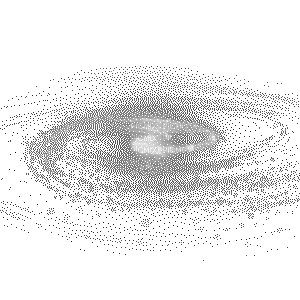They spotted the tiny thing lying on the ground as they crossed an intersection. The variegated yellow leaves and the rough asphalt surface made it hard to distinguish the delicate object at first sight. Along the road, everything glimmered under the strong sunlight — the twinkling candy wrappers, the reflective car windows, even their own glowing, sweaty skin — everything except the nearly invisible piece. Its impenetrable quietude absorbed the ambient heat, street noise, bouncing light, and their wandering attention, like a black hole. Their steps involuntarily paused just a breath away from the unanticipated discovery. It was a flash drive without an outer case, exposing a scratched USB connector and a bare circuit board. The two square holes on the plug seemed to peer back at them, evoking the unflinching stare of a homeless person asking 'what do you want from me?', the eyes of a traveling seagull, having stopped by countless harbors, the gaze of their childhood friend when she spent an entire afternoon watching the clouds.
1 / 6
Years had passed since they last connected with that friend, and their memories about her had gradually faded. They pondered why they could no longer recall her voice, birthday or favorite color. Did the memories evaporate into the air on the warmest summer day? Did they scatter at the intersections they frequently crossed? Was their memory, like that of a flash drive, constantly erased and rewritten with each change of address? It is said that flash memory is named after the camera flash. The team who developed this memory technology thought its data erasing process was so fast that it reminded them of a camera flash. But this analogy also holds a paradox: through a camera flash's brief burst of light, photographers try to capture those shadowy, fleeting moments, and keep holding them. The flash of a camera attempts to remember. Flash memory, however, is designed for letting go.
2 / 6As their life journey moved on, they let go of many things once held tight. They didn't feel sad about losing photos of that childhood friend. Yet, they did wish to keep some of their exchanged notes, hand drawn characters, and a picture of their collaborative dollhouse beneath the school desk. They also wished to still retain their first-ever thumb drive, which they used to carry around. It was a glorious combination of technology, fashion and mystery for a thirteen-year-old. Computers were alien to them back then, as they had just signed up their first email account and learned to send emojis in MSN Messenger. This portable drive stored no digital files; instead, it contained the wild imagination of a kid and their secret fantasies of an approaching future.
3 / 6Countless thumb drives came and went in their life, some still with them, some already gone. They sometimes wondered about the fate of those missing drives — were they working on someone else's device, decomposing in a landfill, or basking in a foreign street? If one lay in the middle of a road, would a passerby pick it up and take it home? Would the person attempt to extract its data, like they did with the drive they found on that sunny autumn afternoon? They failed to access the data in the flash drive due to the severe damage to its connector. The contents within its memory cells became a question to ponder during another afternoon walk. The drive might be empty, akin to their very old one; it might carry a confession letter, carefully sent to someone like messages in glass bottles; it might be loaded with South Park all seasons plus movies, available for $129.99 online with free shipping; or it might contain groundbreaking findings about dark matter in the universe, poised to inspire the whole world.
4 / 6Although the flash drive didn't shake the world, it left an impact on them, who observed its dust like an astronomer studying the stars. They found its birth record: a serial number and the country of origin. It was from an island country, where they also called home. They believed that on its body, beneath all the scratches, dirt, and stains, they could find the same traces of migration — chasing the sun when crossing the vast Pacific Ocean, having a long day in the maze of customs, counting the miles from the West Coast to the East Coast. Despite its flash memory being unusable, the flash drive persisted as a storage medium. Its presence was a lasting reminder of the day they met it on the ground — the sparkling streets, cloudless sky, piled leaves, irresistible black hole, familiar eyes, their ongoing thoughts on loss and return — an abundance of data that took up zero bytes.
5 / 6They slowly realized that they were not only the traveling seagull, but also the waiting harbor. They could never predict when and where things would arrive, depart, or return. This might explain why they habitually scanned the ground while walking. Recently, they noticed lots of chewing gums on the pavement in their neighborhood, and those gums reminded them of flash drives. People left imprints on the gum, preserving the data of their teeth, tongue, saliva, and mouth movements with each bite. Before the gum loses its elasticity, one can edit it multiple times — from bite to bite, from byte to byte. The data would be distributed when the gum left the mouth. A piece of used gum might end up in a trash bin, on a brick wall, or squished onto asphalt, perhaps alongside a dropped flash drive. They would never know the journey of a discarded gum or flash drive, but of one thing they were certain — they will continue walking and having unexpected encounters. Despite their dislike for gum, they did enjoy stumbling upon a Godzilla-shaped chewed piece, feeling the illusory sweetness on their tongue.
6 / 6